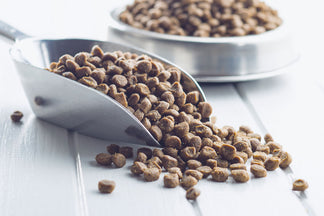When was the last time that you looked, and I mean really looked, at the label on your pet’s food? If you have looked closely, one of the first things you might notice is that the list of ingredients is rather long, and includes many items that you might not understand (or be able to pronounce). The fact is that most pet food labels are hard to understand, and most pet food ingredient labels require a chemistry degree to decipher. So what is a pet owner to do?
The First Five
There is an old saying that you can assess a pet food’s quality by looking at the first five ingredients in the list. The rationale for this rule is that once you get past the first five, the remaining ingredients each individually contribute very small proportions of the food’s total composition. Thus, the first five ingredients can tell the story.
Overall, this rule makes sense, but it is a one size fits all approach that can sometimes be deceptive. The dogfoodproject.com provides an alternative rule: “.. look for the first named source of fat in the ingredient list. Anything listed before that, and including it, make up the main portion of the food, other items are present in much smaller amounts to add flavor, function as preservatives or because of their dietary benefits (e.g. probiotics, vitamins and minerals).” Here is an example from an actual food (from Halo Pets):
Lamb; Whole Peas; Eggs; Oats; Pearled Barley; Chicken Liver; Pea Protein; Vegetable Broth; Flax Seed; Chicken Fat (Preserved With Mixed Tocopherols And Citric Acid); Salmon Oil (Preserved With Mixed Tocopherols);Sweet Potatoes;Apples;Blueberries;Green beans; Carrots; Cranberries; Zucchini; Alfalfa; Calcium Sulfate……
You will notice that the first listed source of fat is the 10th ingredient on the list.
Although I conceptually like this rule better than the “rule of 5”, it only works for dry foods. Most wet foods don’t include explicit fat sources in their list so you won’t be able to find what you are looking for. Here is an example from another Halo Pets food, this time, a wet product.
Beef; Beef Broth; Beef Liver; Chickpeas; Dicalcium Phosphate; Calcium Carbonate; Carrots; Canola Oil; Guar Gum; Cassia Gum; Carrageenan; Blueberries; Cranberries; Flaxseed; Potassium Chloride; Salt; Choline Chloride……
There is no mention of chicken fat, beef fat, or any other ‘fat’ in the list. If you are evaluating a wet food and want to do a quick and dirty analysis, you are forced to stick with the rule of 5.
However, in this day and age, we can do better. Why would you want to look past the first 5 ingredients, or past the first named fat? For starters, to see if the food contains artificial ingredients and colorings. You will never see these listed near the front of the list, so using either of those two rules will not tell you if the food is laden with artificial and often unhealthy ingredients such as Ethoxyquin, Propylene glycol or Blue #2.
One of the features of the Petnet(io) SmartFeeder is software that can help you weed through the pet food ingredient lists to easily determine whether or not a food is appropriate for your pet. Among other benefits, the software will automatically alert you if your pet food contains questionable additives and protein sources. No matter how you scrutinize your pet’s food, it is worth the effort to do so. Feeding your pet the highest quality food for your budget, in the appropriate portions, is the single biggest thing you can do to positively impact your pet’s health and lifespan.


 Food
Food
 Food
Food
 Food
Food
